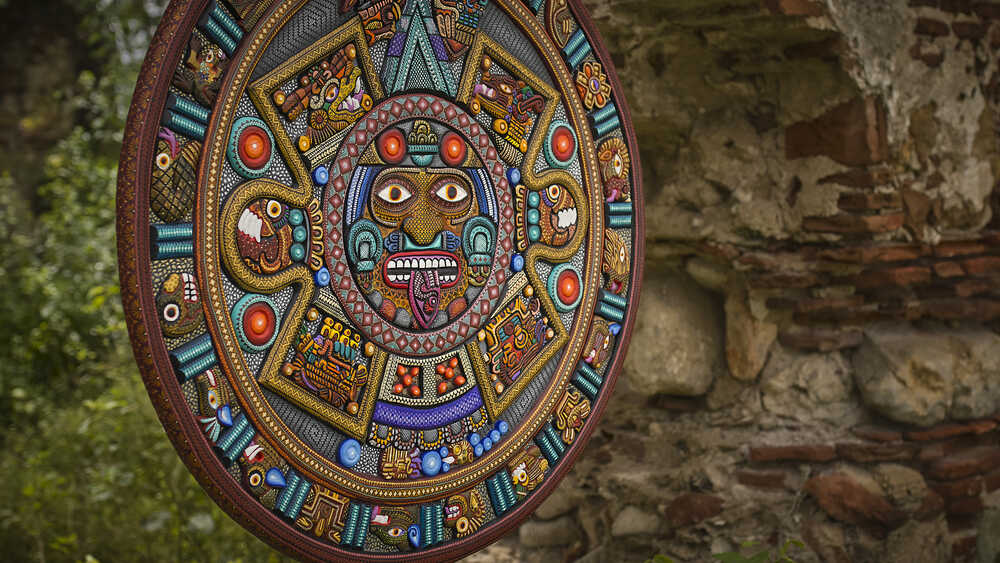WorksPermalink
Together, Mestizaje represents the cultures of the new and old world as they met five hundred years ago in Mexico. Separately, the works speak of beliefs, warriors, historic characters, sacred and imported animals. They weave histories of the pre-Hispanic period, of the Spanish conquest, and of how we might contextualize the past while we create a more informed future.
Artillero (Nagual Bull)
The bull is one of the most iconic representations of the Spanish culture. In this piece, it is portrayed as an artilleryman, and in turn spearhead of Spanish army. It represents heart of fighting force of the conquest from the Spanish perspective, projecting courage, bravery and determination in battle from the character’s place at the front of the army…
Dios de los Naguales
Quetzalcóatl, a mythical creature half serpent, half bird, occupied a divine place among the naguales, or spirit animals of Mesoamerica…
K'ukulk'an
K’ukulk’an, a feathered serpent, a god in the Mayan culture associated with death and resurrection, was seen to possess enormous powers over the earthly realm…
Quetzalcóatl
Cuauhtémoc, which means the sun that descends in the Náhuatl language, was the name of the last ruler, or Tlatoani, of the Aztec empire. He rose to command while the Aztecs were in the midst of full conflict with the Spanish…
Comandante (Rooster Nagual)
The rooster is one of the animals that was brought by the Spanish to Mesoamerica. This Iberian commander is represented as a rooster fit to control and direct the Spanish warriors and allied villages to battle; it was certainly not a simple task and one that required command and leadership to bring order to the battle…
Marina y el primer Mestizo - (Mockingbird and Bull Naguales)
Often regarded as the mother of the concept of mestizaje as it is commonly understood, Marina represents acceptance of Christianity and other European cultural trappings. Often referred to as La Malinche, or traitor, Marina was an interpreter for Cortes and played a prominent role in the colonization of Mexico…
Nagual Guerrero Jaguar
The work represents the most fierce, brave, agile and lethal branch of the Aztec army. One that was, at the same time, in service of the community and a tribute to the connection between dark and light in the world…
El General (Nagual Caballo)
The horse is one of the animals most representative of European power and dominance on arrival in the Americas. Writers and historians have observed that the mere presence of domesticated horses in battled elicited dread among the native population…
Nagual Guerrero Águila
The figure of the eagle warrior symbolizes the ascent to the highest level of human aspiration: The overcoming of normal consciousnesses and the arrival at a higher level of spirituality…
Inframundo (Nagual Conejo muerte)
Mictlán was a name given to a conceptualization of the underworld, the final plane of human existence, where one goes to take the final rest…
Tlatoani (Nagual Xoloitzcuincle)
The ruler of the last Aztec empire is represented in this work in the form of a Xoloitzcuincle, a breed of hairless dog from the Americas. The figure grasps a femur in its hand, a symbol used to physically demonstrate the transfer of power between leaders in Mesoamerica. Man’s best friend is here depicted assisting his people in life, as their final ruler, but as also guiding them to the afterlife…
Macehualiztli ( Nagual Coyote)
Rituals and dances of worship and offering were a common denominator among the people of Mesoamerica…
Ascensión del Jaguar (Nagual Rabbit)
This works represents the triumphant elevation of social and economic status. The figure is of a nagual rabbit of modest origins. Thanks to his glories in battle and to the offerings he has made to his rulers of rival warriors captured in battle, he has ascended to be a jaguar warrior, an elite fighter, a member of the highest level of the Mesoamerican military apparatus…
El Conquistador (Nagual Bull)
The bull is perhaps the most recognizable symbol of Spain and one of the main domestic animals that crossed from the Iberian Peninsula to the New World…
Inconforme (Nagual Wolf)
To free themselves from the oppression they felt, some Mesoamerican peoples sided with the Spanish to overthrow the Aztec Empire…
Netitoliztli (Nagual Axolote)
Besides being performed as a part of spiritual rituals, dance was and continues to also be an expression of joy and pleasure…
Cosmovisión (Sun Dial)
This sun dial is a conceptualization of the world, of reality. It is conceived atop the astrological and spiritual beliefs of the ancient civilizations that inhabited Mesoamerica, along with the knowledge of physics and mathematics that was achieved by those peoples. It incorporates the dictates of space and time that govern the cycle of life and of earth since its origins. All according to the knowledge and beliefs that were passed down between generations in pre-Hispanic times…
Aliado (Nagual Ram)
Gonzalo Guerrero el Renegado was a Spanish marine who’s ship sunk, resulting in his capture by Mayan peoples. He eventually fell in love with the Mayan culture and renounced his origins, defending the community that rescued him against invaders…
Macahuitl
The macauhuitl is a pre-Hispanic weapon made from a length of club-like wood armed with sharp obsidian blades inserted in its sides. It was one of the most powerful and lethal weapons used by Mesoamerican warriors. It was said that a macauhuitl was capable of decapitating a man or even a horse in battle, with only a single blow…
Sincretismo
The work is embodied with the collective meaning of all the other other works that surround it in Mestizaje. It is titled Sincretismo, or syncretism, because the most substantial cultural combination and fusion during the time of the Spanish conquest was mediated via religion…
Mestizaje
The term mestizaje often refers to the mixture of religious beliefs, practices, customs, languages, and traditions between the native population of Mesoamerica and the Spanish colonialists…





















